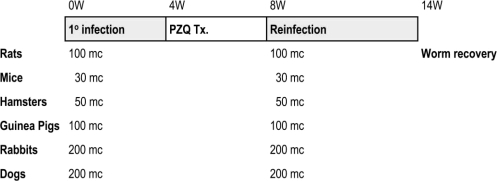Cited By
Citations to this article as recorded by

Factors in the resistance of rats to re-infection and super-infection by Clonorchis sinensis
Hongman Zhang, Byung-Suk Chung, Shunyu Li, Min-Ho Choi, Sung-Tae Hong
Parasitology Research.2008; 102(6): 1111.
CrossRef Fas/FasL-dependent apoptosis of hepatocytes induced in rat and patients with Clonorchis sinensis infection
Xiaoli Zhang, Zhanfeng Jin, Rong Da, Yunxia Dong, Wuqi Song, Xiaobei Chen, Qi Huang, Hong Ling, Yang Che, Yihong Li, Fengmin Zhang
Parasitology Research.2008; 103(2): 393.
CrossRef Identification of two ß-tubulin isotypes of Clonorchis sinensis
Shunyu Li, Sung-Jong Hong, Min-Ho Choi, Sung-Tae Hong
Parasitology Research.2009; 105(4): 1015.
CrossRef Experimental model in rats for study on transmission dynamics and evaluation of Clonorchis sinensis infection immunologically, morphologically, and pathologically
Xiaoyun Wang, Chi Liang, Wenjun Chen, Yongxiu Fan, Xuchu Hu, Jin Xu, Xinbing Yu
Parasitology Research.2009; 106(1): 15.
CrossRef Improved genomic resources and new bioinformatic workflow for the carcinogenic parasite Clonorchis sinensis: Biotechnological implications
Daxi Wang, Pasi K. Korhonen, Robin B. Gasser, Neil D. Young
Biotechnology Advances.2018; 36(4): 894.
CrossRef Mitochondrial genomic comparison of Clonorchis sinensis from South Korea with other isolates of this species
Daxi Wang, Neil D. Young, Anson V. Koehler, Patrick Tan, Woon-Mok Sohn, Pasi K. Korhonen, Robin B. Gasser
Infection, Genetics and Evolution.2017; 51: 160.
CrossRef Clonorchis sinensis and clonorchiasis, an update
Sung-Tae Hong, Yueyi Fang
Parasitology International.2012; 61(1): 17.
CrossRef Strain variation in the susceptibility and immune response to Clonorchis sinensis infection in mice
Md. Hafiz Uddin, Shunyu Li, Young Mee Bae, Min-Ho Choi, Sung-Tae Hong
Parasitology International.2012; 61(1): 118.
CrossRef Local immune response to primary infection and re-infection by Clonorchis sinensis in FVB mice
Eun-Min Kim, Hak Sun Yu, Yan Jin, Min-Ho Choi, Young Mee Bae, Sung-Tae Hong
Parasitology International.2017; 66(4): 436.
CrossRef High-quality reference genome for Clonorchis sinensis
Neil D. Young, Andreas J. Stroehlein, Liina Kinkar, Tao Wang, Woon-Mok Sohn, Bill C.H. Chang, Parwinder Kaur, David Weisz, Olga Dudchenko, Erez Lieberman Aiden, Pasi K. Korhonen, Robin B. Gasser
Immunological underpinnings of Ascaris infection, reinfection and co-infection and their associated co-morbidities
Luisa Magalhães, Denise S. Nogueira, Pedro H. Gazzinelli-Guimarães, Fabricio M. S. Oliveira, Lucas Kraemer, Ana Clara Gazzinelli-Guimarães, Flaviane Vieira-Santos, Ricardo T. Fujiwara, Lilian L. Bueno
Parasitology.2021; 148(14): 1764.
CrossRef Helminths and malignancy
B. J. VENNERVALD, K. POLMAN
Parasite Immunology.2009; 31(11): 686.
CrossRef Unlocking the Transcriptomes of Two Carcinogenic Parasites, Clonorchis sinensis and Opisthorchis viverrini
Neil D. Young, Bronwyn E. Campbell, Ross S. Hall, Aaron R. Jex, Cinzia Cantacessi, Thewarach Laha, Woon-Mok Sohn, Banchob Sripa, Alex Loukas, Paul J. Brindley, Robin B. Gasser, Malcolm K. Jones
PLoS Neglected Tropical Diseases.2010; 4(6): e719.
CrossRef Multiple Exposures to Ascaris suum Induce Tissue Injury and Mixed Th2/Th17 Immune Response in Mice
Denise Silva Nogueira, Pedro Henrique Gazzinelli-Guimarães, Fernando Sérgio Barbosa, Nathália Maria Resende, Caroline Cavalcanti Silva, Luciana Maria de Oliveira, Chiara Cássia Oliveira Amorim, Fabrício Marcus Silva Oliveira, Matheus Silvério Mattos, Luca
PLOS Neglected Tropical Diseases.2016; 10(1): e0004382.
CrossRef First record of a tandem-repeat region within the mitochondrial genome of Clonorchis sinensis using a long-read sequencing approach
Liina Kinkar, Neil D. Young, Woon-Mok Sohn, Andreas J. Stroehlein, Pasi K. Korhonen, Robin B. Gasser, Stephen W. Attwood
PLOS Neglected Tropical Diseases.2020; 14(8): e0008552.
CrossRef Dose-response effects of multiple Ascaris suum exposures and their impact on lung protection during larval ascariasis
Chiara Cássia Oliveira Amorim, Denise Silva Nogueira, Ana Clara Gazzinelli-Guimarães, Thais Leal-Silva, Fernando Sérgio Barbosa, Fabrício Marcus Silva Oliveira, Lucas Rocha Kraemer, Raquel Martins de Almeida, Jorge Lucas Nascimento Souza, Luisa Mourão Dia
PLOS Neglected Tropical Diseases.2024; 18(12): e0012678.
CrossRef Unraveling the relationship among inflammatory responses, oxidative damage, and host susceptibility to Opisthorchis viverrini infection: A comparative analysis in animal models
Sirikachorn Tangkawattana, Watcharapol Suyapoh, Nathamon Taiki, Paramin Tookampee, Ravisara Chitchak, Theerayut Thongrin, Prasarn Tangkawattana
Clonorchis sinensis and Cholangiocarcinoma
Eun-Min Kim, Sung-Tae Hong
Journal of Korean Medical Science.2025;[Epub]
CrossRef Changing Patterns of Serum and Bile Antibodies in Re-infected Rats with Clonorchis sinensis
Hongman Zhang, Byung-Suk Chung, Shunyu Li, Min-Ho Choi, Sung-Tae Hong
The Korean Journal of Parasitology.2008; 46(1): 17.
CrossRef Pathological Lesions and Inducible Nitric Oxide Synthase Expressions in the Liver of Mice Experimentally Infected with <i>Clonorchis sinensis</i>
Qing-Li Yang, Ji-Qing Shen, Yan Xue, Xiao-Bing Cheng, Zhi-Hua Jiang, Yi-Chao Yang, Ying-Dan Chen, Xiao-Nong Zhou
The Korean Journal of Parasitology.2015; 53(6): 777.
CrossRef Perturbations of Metabolomic Profiling of Spleen From Rats Infected With Clonorchis sinensis Determined by LC-MS/MS Method
Xiaoli Zhang, Xinyi Hu, Rui Chen, Beibei Sun, Yannan Gao, Shanshan Duan, Liyan Liu, Su Han
Frontiers in Molecular Biosciences.2020;[Epub]
CrossRef Combinatorial Treatment with Praziquantel and Curcumin Reduces Clonorchis sinensis Parasite Burden and Clonorchiasis-Associated Pathologies in Rats
Soon-Ok Lee, Ki Back Chu, Keon-Woong Yoon, Su In Heo, Jin-Ho Song, Jianhua Li, Sung-Jong Hong, Fu-Shi Quan
Pharmaceutics.2024; 16(12): 1550.
CrossRef


